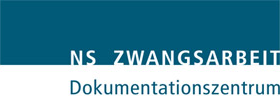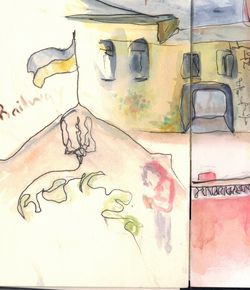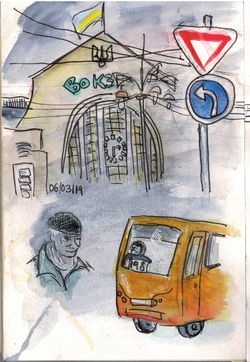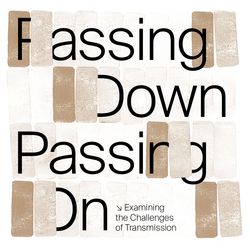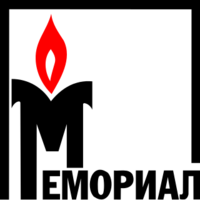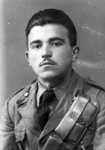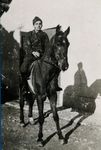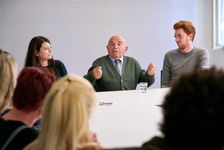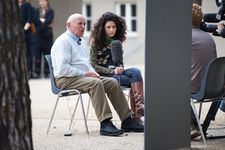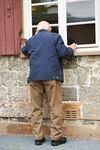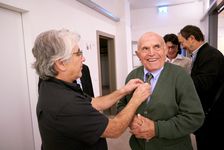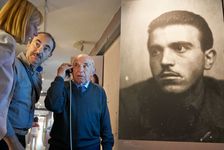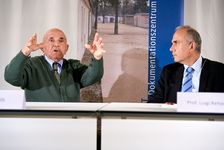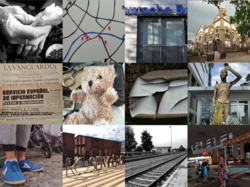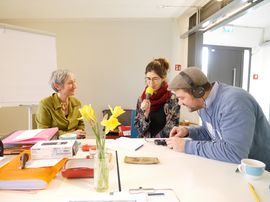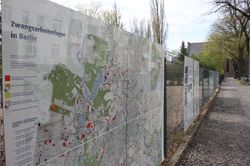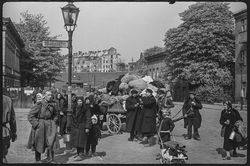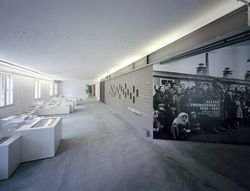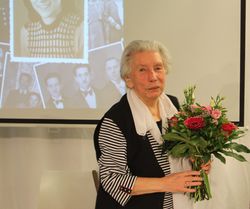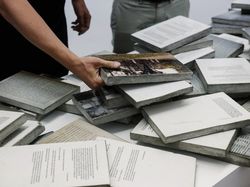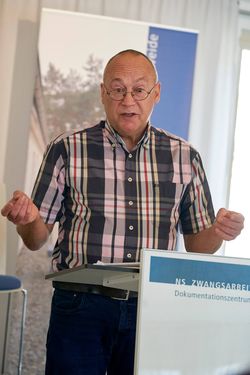
Conversation with Ton Maas - son of a Dutch forced labourer
From 24-29 April 2023, the Nazi Forced Labour Documentation Centre, in cooperation with the Berlin Underworlds, organised a five-day educational holiday "Under the Cover of Work - Forced Labour 1938-1945". Lectures on forced labour under National Socialism alternated with excursions to places of forced labour in Berlin - such as Tempelhof Airport, the high bunker on Pallasstraße, AEG in Berlin Wedding, medical care in the "Mahlow Hospital for Foreigners".
On Wednesday, we were able to welcome the Dutchman Ton Maas with his sister and two of his children for a lecture and discussion. The father Kees Maas met his German wife Martha during forced labour in Berlin 1943-1945. After the war they lived in the Netherlands and had four children. With the father's diary, letters and photos, Ton Maas wrote a book after intensive research, which was published under the title "Liefs uit Berlijn: Het dagboek van Kees Maas (1943-1945)".
The next seminar, "Under the Cloak of Labour. Forced Labour 1938-1945" will take place from 25 - 29 September 2023. There are still places available.
Podcast Workshop - Česko-německá výměna mládeže 2022
The students from Gymnázium in České Budějovice and Freie Waldorfschule in Berlin-Südost developed this storytelling podcast in October 2022 during an international youth meeting in the Nazi Forced Labour Documentation Centre. In order to produce this podcast they worked with the life-stories of Czech forced labourers during WWII. This project is a cooperation with Živá paměť.
Credits:
Podcast Workshop and Production: Nora Hespers
Music: Memoriam Michail (ID 1816) by Lobo Loco
Interviews with Mr. Merta und Ms. Jeníková: CeDiS
Call for donations from the aid network for survivors of Nazi persecution in Ukraine
18 March 2022
The war in Ukraine has caused great hardship for many people. Among those suffering are also thousands of survivors of National Socialist persecution. They need our help now more than ever.
On the initiative of the association KONTAKTE-KOHTAKTbI, an aid network for survivors of Nazi persecution in Ukraine has now been founded. It consists of around 30 initiatives, foundations, places of remembrance and memorial sites in Germany that deal with Nazi crimes and in some cases maintain long-standing contacts with survivors as well as with specialist colleagues and cooperation partners.
Appeal for donations
With the help of donations we would like to realise a coordinated and unbureaucratic support of former Nazi persecutees, their relatives and partners of the network. Further information and the donation account can be found here.
www.hilfsnetzwerk-nsverfolgte.de
Mit Hilfe von Spenden möchten wir eine koordinierte und unbürokratische Unterstützung von ehemaligen NS- Verfolgten, ihrer Angehörigen und Partner*innen des Netzwerks realisieren. Weitere Informationen und das Spendenkonto finden Sie hier.
www.hilfsnetzwerk-nsverfolgte.de
Presseerklärung Spendenaufruf als PDF
Interview mit Leiterin Dr. Christine Glauning im Deutschlanfunk Kultur
20 places of remembrance and memorials from the german "Networking meeting on Nazi Forced Labour" call for an end to the Russian attack on Ukraine
1 March 2022
20 places of remembrance and memorials from the german "Networking meeting on Nazi Forced Labour" call for an end to the Russian attack on Ukraine. The declaration of solidarity with Ukrainian citizens - including former forced labourers.
Wording of the appeal
We are deeply concerned about the escalation of the situation and the russian attack on Ukraine. Our thoughts are with the Ukrainian people, our colleagues with whom we have been working together in a spirit of trust for many years. But we also think with great concern of the aged former forced labourers whose lives are now again affected by war and destruction. We demand an end of the fighting.
Signatories from "Networking meeting on Nazi Forced Labour"
Dokumentationszentrum NS-Zwangsarbeit
Dokumentationsstelle Pulverfabrik Liebenau e.V.
Denkort Bunker Valentin / Landeszentrale für politische Bildung Bremen
Gedenkstätte für Zwangsarbeit Leipzig
Gedenkstätten Gestapokeller und Augustaschacht
Gedenkstätte Lager Sandbostel
Gedenkstätte Breitenau
Gedenkstätte und Museum Trutzhain
Gedenkstätte Stalag 326 (VI K) Senne
Gedenkstätte ROTER OCHSE Halle (Saale)
Gedenkstätte Zuchthaus Brandenburg-Görden
Gedenkstätte für die Opfer der Euthanasie-Morde in Brandenburg an der Havel
Gedenkhalle und Bunkermuseum / Stadt Oberhausen
Geschichtsort Adlerwerke: Fabrik, Zwangsarbeit, Konzentrationslager
Geschichtswerkstatt Göttingen - Ausstellung "Auf der Spur europäischer Zwangsarbeit. Südniedersachsen 1939-1945"
Interviewarchiv "Zwangsarbeit 1939-1945. Erinnerungen und Geschichte" / Freie Universität Berlin
Mahn- und Gedenkstätte Ravensbrück
Museum Zwangsarbeit im Nationalsozialismus / Stiftung Gedenkstätten Buchenwald und Mittelbau Dora
NS-Dokumentationszentrum der Stadt Köln
NS-Dokumentationszentrum München
Stiftung „Erinnerung, Verantwortung und Zukunft“
Stiftung Hamburger Gedenkstätten / KZ-Gedenkstätte Neuengamme
Stiftung niedersächsische Gedenkstätten / Gedenkstätten Bergen-Belsen und Wolfenbüttel
Studienkreis Deutscher Widerstand 1933-1945 e.V.
Passing Down, Passing On
Examining the Challenges of Transmission
10. - 14. Januar 2022
(Despite difficult times) we are very happy to welcome the participants of the "Passing Down, Passing On" project in our International Youth
Meeting Centre. During the week 16 memorial workers and teachers from Germany and France and a colleague from the National Museum
of the History of Ukraine in World War II exchange ideas on the subject of NS-forced labour and develop an international youth
meeting together.
The project is a cooperation with the internment and deportation memorial in Compiègne, the Langenstein-Zweiberge memorial. It's part of #youngpeopleremember.
Places of remembrance and memorial sites show solidarity with "Memorial"
23. November 2021
The Russian Prosecutor General's Office has opened "liquidation proceedings" against Memorial International in Moscow. The trial will take place next Thursday, 25 November before the Russian Supreme Court.
The solidarity action for "Memorial", initiated by the Topography of Terror Foundation, is joined by memorials and memorial sites throughout Germany. The resolution and the signatories are attached.
Wording of the resolution
We react with dismay to the application of the Russian Prosecutor General's Office to dissolve the organisation "Memorial". We protest against the attempt to make the so important work of the non-governmental organisation for human rights and for coming to terms with tyranny in history and the present impossible.
We call on the Russian authorities not to hinder the civil society engagement of Memorial and other organisations as well as the international exchange.
Memorial has gained international recognition since 1992 with its invaluable commitment to citizens in Russia and beyond. As a broad-based and independent institution, Memorial was and is also of great importance for relations between Germany and Russia. Above all, the historical reappraisal and especially the National Socialist crimes committed in the Soviet Union have always been the focus of its work. Memorial has fought tirelessly for the compensation of Soviet forced labourers and has campaigned for many years to give them and other Nazi victims a voice. Numerous Nazi memorial sites and places of remembrance have repeatedly initiated and carried out projects together with Memorial. They value Memorial as a credible and important voice, among other things in various committees of memorial and remembrance sites. In addition, Memorial is in regular contact with many of our institutions through its archives and its library and museum.
The work of Memorial, which is so important, must in any case be secured for the future.
First signatories
Dr. Andrea Riedle, Director of the Topography of Terror Foundation
Dr. Christine Glauning, Director of the Documentation Centre Nazi Forced Labour
Dr. Thomas Lutz, Head of the Memorial Department at the Topography of Terror Documentation Centre

What traces does forced labour leave behind? What does it mean for us today?
In July 2021 a group of eleven volunteers from seven different countries searched for traces of forced and unfree labour in their own environments. This was the main focus of the second digital study camp that was hosted by the International Youth Meeting Centre in cooperation with Service Civil International Germany.
The participants studied the history of forced labour during the Second World War and explored different forms of forced and unfree labour today. During a two-week project they created their our own photo exhibition that portrays how they encountered the topic of forced labour and what these encounters meant for them.
The last eyewitness of the forced labour camp in Schöneweide
Obituary for Ugo Brilli
The Nazi Forced Labour Documentation Centre mourns the death of Ugo Brilli. The last survivor of the former forced labour camp in Berlin-Schöneweide, which now houses the Nazi Forced Labour Documentation Centre, died on 17 June 2021 in his native Tuscany at the age of 99.
At the age of 21, the Tuscan farmer and woodcutter Ugo Brilli begins a two-year period of suffering as a young prisoner of war and forced labourer. In September 1943, Italy withdraws from the alliance with Nazi Germany. The Wehrmacht then takes Italian soldiers prisoner, deports them to the German Reich and declares them military internees.
Among the total of 650,000 Italians is Ugo Brilli, who had been drafted into military service by Italy's army only a few months earlier. The radio operator stationed on the border with Slovenia first ends up in a collection camp in Luckenwalde in Brandenburg. From there, like around 30,000 comrades, he arrives in Berlin as a forced labourer. At first he had to clear rubble at Siemens, later he had to work in a carpentry workshop.
Ugo Brilli is released from captivity in 1944. However, he has to remain in Berlin as a civilian forced labourer. He is placed in forced labour camp No. 40 in Berlin-Weißensee. There he bribes the German cook in the camp kitchen with cigarettes, which he exchanges for bread on the black market, for example. In this way he secures a comparatively better job as a kitchen assistant and a little more food for himself and some of his comrades.
He survives a bombing raid on the forced labour camp on 7 May 1944, in contrast to 53 Italians who die in the camp's anti-splinter trenches. Brilli never forgets that day for the rest of his life. "Before I die, I want a memento of those poor comrades who died there," he says in a television interview in 2017.
This memento has existed since May 2021. On the initiative of Ugo Brilli, an information and memorial plaque erected by the Pankow Memorial Plaque Commission and the Nazi Forced Labour Documentation Centre now commemorates Ugo Brilli's killed comrades at the former camp site in Weißensee. He takes great pleasure in this new memorial sign, which is so important to him, on the basis of photos sent to him of it. He is no longer able to travel to Berlin for the inauguration.
There are several reminders of Brilli in Schöneweide. At the end of 1944, Brilli was sent from Weißensee to camp no. 75/76, the present site of the Nazi Forced Labour Documentation Centre. He worked again as a kitchen helper.
Brilli spent the last days of the war in 1945 mainly in one of the air-raid shelters there. After the liberation by the Red Army, he initially had no choice but to search for food supplies in the cellars of the surrounding houses in order to survive.
After the end of the war, the Russians put him to work dismantling a factory outside Berlin.
In September 1945, Ugo Brilli, who weighed only 48 kilograms and was seriously ill with typhus, was finally able to return to his family in Tuscany. Back home, the former military internee builds a new life for himself without any compensation or recognition for his imprisonment in Germany. He works in the forest again, marries and has two children.
Later he visits Germany and returns several times to the historical site of the former forced labour camp in Schöneweide. On 7 May 2013, for example, he speaks about his fate at the opening of the first permanent exhibition, "Forced Labour in the Daily Round 1938-1945". He shares his memories with school classes in both countries. In recognition of his valuable contribution to a common culture of remembrance in Germany and Italy, Brilli will receive the Federal Cross of Merit of the Federal Republic of Germany on 9 December 2019.
Now Ugo Brilli, the last contemporary witness who was able to tell so perceptively and pointedly about his time of suffering as a prisoner and forced labourer in the Second World War, has died at the age of 99 in Campi Bisenzio near Florence.
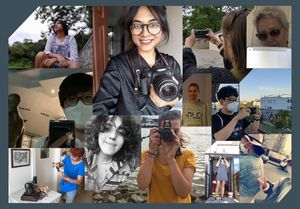
Online Study camp "Searching for Traces of Forced Labour"
Call for Applications
For the second time we are organising an online study camp "Searching for Traces of Forced Labour" in cooperation with Service Civil International Germany.
The main idea of the project is to prepare a digital photo exhibition on the topic of Nazi forced labour and modern forms of free and unfree labour.
You will be invited to search for traces of forced labour in your home country and to document the results with the camera.
No prior knowledge in photography is necessary. You will get an introduction by a professional photographer.
We'll meet online (Mon-Fr) between 12-23 of July, Mon-Fr, for max. 3 hours a day 10-13 CET.
You can read more about the project here:
https://workcamps.sci.ngo/icamps/DE-SCI/de/camp-details/camp-14839.html
You can see the exhibition from last year's study camp here:
https://ausstellungen.deutsche-digitale-bibliothek.de/searchingfortraces
To register, please contact your local SCI branch or Tanja Vaitulevich at vaitulevich(at)topographie.de.
Short film "Karya 1943 - Deadly forced labour in occupied Greece"
The Foundation Memorial to the Murdered Jews of Europe and the Nazi Forced Labour Documentation Centre commemorate a hitherto little-known chapter of the Holocaust with the short film "Karya 1943". The film highlights the deadly forced labour of Jewish men in the mountains of central Greece on the Athens - Salonika railway line in 1943.
80 years ago, the army of the Kingdom of Greece capitulated to the Wehrmacht, which had invaded the country. Years of plundering, starvation and mass murder followed under German occupation. This included the almost complete annihilation of Jewish life.
Near a village in Karya, a level siding was to be literally hammered into the rock to make it easier for waiting trains to start again in the future. The work was carried out under great time pressure in shifts. The approximately 300 Jewish prisoners received only mouldy food and hardly any water. Working clothes were not provided. Sadistic foremen and supervisors, Germans, Croats and Romanians, beat them.
More than 15 years ago, the Greek collector Andreas Assael - himself the son of a Jewish survivor - acquired a photo album at a Munich flea market that shows numerous photographs of forced labour in Karya. He succeeded in finding contemporary witnesses and researching details of the operation. In cooperation with Andreas Assael, the Foundation Memorial and the Nazi Forced Labour Documentation Centre are now working on the concept of a German-Greek travelling exhibition, which is to open in both countries in 2023. The Federal Foreign Office funded a pilot project in 2020/2021 to further research the crime and locate the mass grave near the site.
The short film by Berlin-based director Stefan Auch introduces this important German-Greek reconciliation project.
Contact:
Dr. Ulrich Baumann, Foundation Memorial to the Murdered Jews of Europe, Tel: +49 (0)30 26 39 43 - 27, ulrich.baumann(at)stiftung-denkmal.de
Dr Kay Kufeke, Nazi Forced Labour Documentation Centre, Tel: +49 30 6390 288 13, kufeke(at)topographie.de
Online Exhibition: Digital Study Camp
In August 2020 the International Youth Meeting Centre hosted its first digital study camp “Searching for Traces of Forced Labour” in cooperation with Service Civil International Germany. Twelve participants from Bangladesh, China, Germany, Italy, Mexico, Serbia, South Korea, Spain, Turkey and Ukraine searched for traces of forced labour in their home countries. They focused on Nazi forced labour and other examples from the Second World War period but also on modern forms of forced and unfree labour. In less than two weeks they created a digital exhibition “Forced and Unfree Labour. Our Point of View” where they presented their visual stories.
The Nazi Forced Labor Documentation Center will open its exterior grounds from Tuesday, May 12, 2020
The Nazi Forced Labour Documentation Centre will reopen the historical site of the former Nazi forced labour camp on Tuesday, 12 May. For the time being, access is restricted to a maximum of 50 visitors, subject to the rules of distance. From Tuesday to Sunday, 10 a.m. to 6 p.m., visitors can inform themselves about the history of the Berlin-Schöneweide forced labour camp in the extensive outdoor area.
The exhibition of the Berlin regional museums "Forced Labour in Berlin 1938-1945" is still accessible without restriction, regardless of the opening hours at the outer fence to Britzer Straße.
The date for the reopening of the two permanent exhibitions as well as the opening of the planned special exhibition "Ausgeschlossen. Archäologie der NS-Zwangslager" will be announced in time.
The current online project for the liberation of the camps in Berlin will be continuously expanded until the end of May with new information and voices of surviving forced laborers: https://www.zwangslager-berlin-1945.de/en/
Result of the podcast workshop "(His)Stories in the ear, pictures in the head
In February, the four-day podcast workshop "Story(s) in the ear, pictures in the head" took place at our documentation center. Xenia and Florian dealt with the topic of forced labor under National Socialism, interviewed visitors and talked to Corinne Douarre, daughter of a French forced laborer, about musical memory work.
You can listen to the (German) result of their recordings here.
Fence Exhibition: Forced Labour in Berlin 1938-1945
We are currently not allowed to let guests into our exhibitions, so we bring an exhibition to the guests. From April 13, the exhibition "Forced Labor in Berlin 1938-1945" will be on the fence of the Documentation Center Ns-Forced Labor along Britzer Strasse.
Who were the people who had to do forced labor in Berlin, where did they come from and under what conditions did they have to live and work? Who were the profiteers and who organized and administered the use of forced labor? What was the post-war fate of the survivors? What traces did the mass deployment of forced labor leave behind in the Berlin urban space and in the memory of the Berlin population? These and other questions are explored in this exhibition, which was developed on the basis of regional research conducted by eleven regional museums and institutions in 2002.
Online project: Finished but not over. Nazi forced labor camp in Berlin 1945
When the city of Berlin surrendered to the Red Army on 2 May 1945, there were approximately 370,000 forced labourers in the entire city area. Prisoners of war, concentration camp prisoners and so-called civilian workers. Most of them were still in their places of work and in the camps at the end of the war. The weeks of April and May 1945 were marked by hunger, desperation, fear, resistance and hope.
Many former forced labourers from Western and Southern Europe were still able to return to their home countries in summer 1945, either alone or with the help of Allied repatriation transports. Other liberated persons tried to resist the repatriation. Particularly in the Soviet Union, those returning were long suspected of treason and collaboration with the Germans.
The history of the liberation of the Nazi forced labour camps in Berlin has not yet been comprehensively reappraised. In commemoration of the end of the war, we take the 75th anniversary as an opportunity to turn our attention to the former forced labourers. How did they experience the last weeks of the war? What was their first contact with the Allies like? What happened to the liberated camps?
On our blog zwangslager-berlin-1945.de we document eyewitness reports, diary excerpts, letters and memories from the Berlin area.
You can also find information on our social media channels at #Zwangslager1945 #75Befreiung #75liberation
Closed 13 March until further notice
Dear visitors,
The Nazi Forced Labour Documentation Centre, like all Berlin memorial sites, will be closed from 13 March until further notice for current reasons.
Unfortunately, no public guided tours or events can take place during this period.
We ask for your kind understanding.
Stay healthy!
Dr. Christine Glauning and the team of the Nazi Forced Labour Documentation Centre
On the death of Vera Friedländer
On October 25, 2019, Vera Friedländer died at the age of 91. The National Socialists had persecuted the Berlin woman as a "half-Jew". At the age of 16 she had to do forced labor in various companies, including a shoe repair shop of the Salamander company in Kreuzberg.
Later, the Germanist became involved and emeritus professor for the reappraisal of forced labor. This year she visited the Documentation Centre for Nazi Forced Labor again and talked to young people about her history of persecution.
Mrs. Friedländer's voice will be missing. She understood that people listened to her and thought about her words. We, employees of the Documentation Centre, were also influenced by her visits.
GE-SCHICHTE_N. A participative installation by Jolanda Todt
21 August - 27 October 2019
The installation GE-SCHICHTE_N by the artist Jolanda Todt invites visitors to look at the German occupation of Poland 1939-1945 - literally touching history. The artwork consists of 60 concrete panels on which various materials have been applied: modern photographs, historical documents, and excerpts from a contemporary witness interview. Each concrete slab opens up a different approach to history. The fragments can combine with individual prior knowledge and associations. Only by carefully analysing the materials can visitors learn that the spread of history also conceals a personal story. The more visitors deal with the material, the narrower the framework within which the information can be interpreted.
